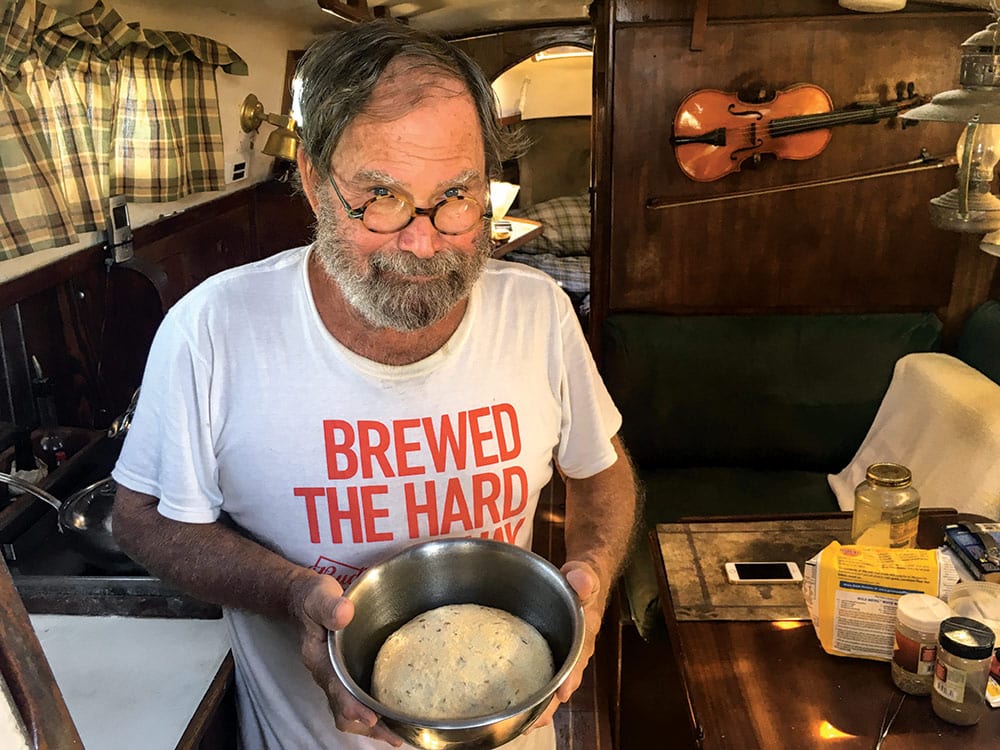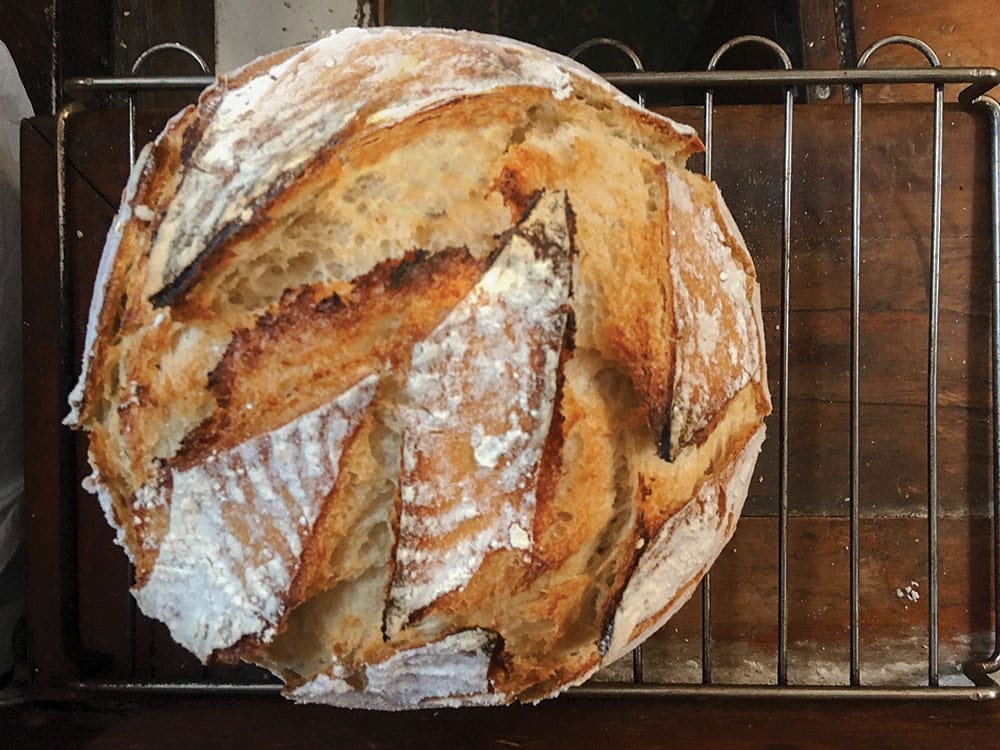
The battery bank of Christina was topped off, thanks to a buzzing wind generator working overtime from the Christmas winds in the harbor of Charlotte Amalie in St. Thomas, U.S.V.I.
Good thing, because Ed Buffkin was baking.
“This fries my inverter,” he said, as he leaned over his electric dough mixer. He scooped ingredients into the attached metal bowl in what was clearly the exact right amount.
“It’s an eyeball thing, a feeling,” he shrugged, brushing off a mastery that came from decades of experience baking in top Parisian schools, exclusive resorts, and restaurants throughout the United States and the Caribbean.
Now a spry 70 years old, Buffkin is technically retired but fetches up to $40 a loaf, baking artisan wonders for fellow cruising friends aboard his 30-foot Alpa sailboat. “After I retired, I got bored and decided to bake sourdough bread,” Buffkin said. “Everyone liked it, and I’ve always loved a challenge, so I kept at it. It’s also a way to feed the cruising kitty.”
Half of his V-berth is converted into a proofing station for bread to rise. The gimballed oven has been overhauled with ceramic tiles and a digital thermometer for constant temperature monitoring, just in case the wind funneled in from the hatches blows out the pilot light. Jars of sourdough starters line his galley, and the starboard storage space is almost completely filled with bags of flour.
He bakes only special orders cultivated solely by his friends-turned-fans. Bring up his name most anywhere in the Virgin Islands and much of the Caribbean, and mouths start watering.
“Really good bakers are doing what I’m doing, creating small batches of artisan breads made with passion,” he said. “People should tell you it’s really, really good. That’s the mark of a good baker.”
Buffkin’s chewy, golden loaves — with crusts split perfectly as to catch the edges of sandwich fillings — run around $20, and cruisers clamor to pay. His specialty breads, like an apple cinnamon loaf that wafted a heavenly aroma throughout the mooring field, cost more.
Pumpernickel or rye, whole wheat or simply sourdough, his bread is good. Really, really good.
The fact that he bakes on a 1992 Italian-built sailboat with a propane tank that requires a constant eye and no watermaker only adds to the mystique of the final product.
“Twenty dollars really isn’t a lot when you think about what I have to do to make bread on the boat,” Buffkin said.
To pick up an extra bag of specialty flour, he has to take his constantly deflating dinghy to the dock near a health food store within walking distance. Jugs of fresh water line his cockpit, as water by far is the limiting factor in his production. When a nearby vessel pushes a wake his way, he has to be extra careful not to burn himself or break his prized ceramic baking vessel.
Still, the value in his bread, what makes his friends pay top dollar for specially ordered loaves especially during holidays and before making passages, isn’t in the floating bakery. Buffkin is a master baker.
“I learned from every chef I worked with, and I’ve worked with a lot of them,” he said without a hint of inflated pride, his shy eyes peeking out from round tortoise-shell glasses. “I know the smell, the look, the shape. It’s taken a lot of trial and error to get to where I am.”
RELATED: People and Food: Offshore Banana Pancakes
Always a creative person, Buffkin studied baking in Paris before working a summer job at a lodge in Jackson Hole, Wyoming. As the night baker, he was responsible for churning out 20 dozen muffins and French breads for the morning rush. Then he worked in a German restaurant in Charleston, South Carolina, where he apprenticed under a Prussian baker who taught him the art of making stollen, a sweet and spicy rum-infused butter bread filled with nuts and fruit that’s popular during holidays. Having mastered sweets, he worked as pastry chef at the Ritz-Carlton in Atlanta before being recruited to join the exclusive Caneel Bay Resort in St. John, where he bought Christina. After working in another posh resort in St. Lucia, he sailed back to St. Thomas, where he ran his own bakery in Frenchtown, supplying fresh breads and pastries to resorts and grocers throughout the islands.

Ask him about his favorite desserts he’s created and he’ll paint a chocoholic dream of carved perfection, waxing nostalgic about dripped ooey-gooey goodness that will cause tummies to rumble.
Due to the high demand and cramped quarters, Buffkin has baking on board down to a science. “I want to make it convenient for me, on this little boat, with just me. I don’t want to have flour everywhere,” he said.
On the day I watched, it all began with his starter, a mixture of yeast, water and flour, which he has kept in an airtight container on his galley counter for the last six years. It is a tangy and complex sour base that to which he added, along with water, a little honey, a little more yeast and flour, into a metal bowl that fits perfectly in his electric dough mixer that he balanced on the companionway stairs.
As the mixer swirled, he added salt dissolved in a little water and kept the sides of the bowl clear with a rubber spatula.
“I have to make sure there are no lumps,” he said, using a free hand to poke the dough as it churned.
He converted his recipe to cups and spoons after realizing his old method of measuring by weight wouldn’t work. Scales and boats don’t mix; he eventually threw his electronic scale away.
Once the dough consistency was just right, he switched off the machine and rolled the dough into a log, poked it gently with all ten fingers, then folded it back into a log before making it a nice ball.
Knead too much — a classic rookie mistake — and the dough starts to tear like a muscle. If you don’t add enough salt — another lesson he learned over the years — the flavor of the sourdough won’t pop on the tongue.
Next, he sprayed a plastic Tupperware bowl with butter spray and added the dough, covering it with plastic. The bowl went straight to a shelf he built specifically for proofing in the V-berth.
“It’s kind of cool in the V-berth, but when the sun hits directly, the proofing doesn’t take long at all,” he said, putting away ingredients as he worked.
Checking his watch, he estimated it would take about an hour for it to rise above the lip of the bowl. Some days, he waits it out by reading or checking Facebook. But he had a rye bread order to prepare, and he had to get right to it.
In between the dance of baking the next loaf, he checked the sourdough dough. When it was time to “knock it down,” again he was gentle. He used the palms of his hands to spin the dough enough to remove it from the plastic bowl and put it into a specialized ribbed basket he dusted with cornmeal. Once more, he covered it with plastic and returned it to the V-berth.
He lit his pilot light — after closing a hatch — and checked the digital thermostat. Inside his little oven, he heated a ceramic dish, which he ordered online after measuring his stove to make sure it would fit, to prepare for baking. Once heated to 375 degrees, he carefully removed the clay vessel — this too sat on the companionway steps — and popped the risen dough in. With a razor blade, he slashed the top artfully and returned it to the oven.
“It’s nice when you have a breeze, but not when it blows out your pilot light,” he said, constantly checking the thermostat for the 20 minutes while the bread baked.
Once emerged, the loaf boasted a perfect, golden crust containing a chewy center awaiting a dip into garlicky olive oil. But Buffkin wasn’t impressed. He felt he rushed the proofing phase.
“It’s still going to taste good,” he shrugged, turning to the next task of rye bread. This loaf, he knew, would be even better.
“You can do anything if you put your mind to it,” he said.
- Suzanne Wentley is currently land cruising in Australia.*
Ed’s Basic Bread
Want a simple recipe to start baking bread? Start with Ed’s quick and easy beginner recipe:
Ingredients:
- 1 teaspoon yeast
- 1 cup water
- 3 cups flour (more as needed)
- 1 teaspoon honey
- 1 tablespoon salt, dissolved in 1⁄2 cup water
Directions:
Add all ingredients except salt to a gallon plastic bag, seal and work until mixed. Add more flour slowly until it becomes dough and stops clinging to the sides. Add the salt, dump on the counter and knead gently. Let dough rise until doubled, then knock down and rise again for another 20 minutes. Bake in preheated oven at 375 degrees for about 20 minutes.








